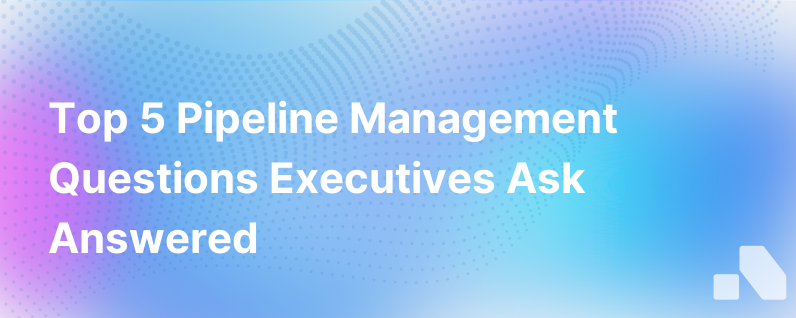
Effective pipeline management is the beating heart of any successful sales strategy. It offers more than just a snapshot of potential revenue; it's a roadmap for the sales journey, highlighting where you're going and how you'll get there. Yet, for many B2B sales leaders, the nuances of pipeline management remain a complex puzzle.
At Aomni, we frequently encounter questions regarding the optimization and maintenance of sales pipelines. In this comprehensive article, we will dive into the top five questions we hear about pipeline management and deliver insightful, actionable answers. This should not only dispel common misconceptions but also enhance your understanding and empower you to harness your company's sales potential fully.
1. What exactly is pipeline management?
Pipeline management is the process by which sales leaders track and oversee every stage of the sales process. Each deal is plotted in its respective stage, from lead generation to final negotiations and closing. Effective pipeline management demands that you not only understand the current state of play across all active deals but also anticipate future developments, manage resources, and strategize accordingly.
The pipeline is frequently visualized as a funnel, wider at the top, where numerous leads enter and progressively more narrow as potential deals are vetted and qualified, cradling them through to the final stages of sealing a deal. Good pipeline management ensures that there are no blockages, leaks, or falls through the cracks - every opportunity is maximized, and no lead is left behind.
2. How do you measure the health of your pipeline?
Assessing the health of your pipeline requires looking at a mixture of quantitative and qualitative metrics. Here are the crucial metrics to consider:
- Pipeline Value: Look at the total worth of all opportunities at each stage of the pipeline.
- Win Rate: This is your conversion ratio of quotations or proposals to sales.
- Sales Velocity: Measure the average time it takes for a deal to move from the pipeline's entry point to a closed sale.
- Deal Slippage: Take note of deals that take longer to progress than anticipated, indicating possible issues in the sales process.
Other nuanced aspects include the quality of leads, stage duration, and pipeline flow. Are the leads well-qualified? Are there stages where deals consistently get stuck? Is there a steady advancement of opportunities from one stage to the next? A balanced and healthy pipeline should have a good mix of early-stage leads, mid-funnel negotiations, and ready-to-close deals.
3. What strategies can improve your pipeline's flow?
Improving pipeline flow is about reducing friction and speeding up the sales cycle. Here's how you can do that:
-
Enhance Lead Quality: Use refined lead scoring systems and marketing collaboration to ensure high-quality leads.
-
Streamline Your Sales Stages: Review and adjust your sales stages regularly for relevance and efficiency.
-
Leverage Sales Enablement Tools: Arm your sales team with the tools and information they need to move leads through the pipeline effectively.
-
Nurture Leads Consistently: Use automated email sequences, content marketing, and personal outreach to keep prospects engaged.
-
Close Feedback Loops: Use data and feedback to inform ongoing adjustments to your sales tactics and strategy.
4. How should you handle stalled deals?
Deals can stall or slow down for various reasons. Identifying why a deal is stuck is the first step in determining how to re-engage the prospect. Common strategies include:
-
Reassess Prospect Needs: Reengage with key stakeholders to reaffirm their needs and how your solution aligns with them.
-
Provide Additional Value: Sometimes, sharing new insights or resources can invigorate stalled negotiations.
-
Optimize Timing: Patience can be crucial. Timing issues can be deal-specific, often requiring customized follow-up strategies.
-
Evaluate Deal Viability: Consider whether it's in your best interest to continue pursing the deal or to reallocate resources to more promising opportunities.
5. How often should sales pipelines be cleaned?
The sales pipeline should undergo regular maintenance to prevent the buildup of dead-end leads that can skew your forecasting and waste resources. This process, often referred to as 'pipeline hygiene', includes actions like:
- Monthly Reviews: At a minimum, review the pipeline's integrity each month, ensuring all data is up to date and accurate.
- Quarterly Audits: Conduct a more thorough assessment quarterly to analyze wins, losses, and longer-term trends.
- Annual Overhauls: Once a year, do a deep dive to review processes, adjust strategies, and align goals for the new fiscal calendar.
Proper pipeline hygiene ensures that your sales team focuses on the most promising leads, saves time, and boosts your bottom line.
Conclusion
Mastering pipeline management can be the difference between simply hitting targets and truly excelling in the B2B sales space. By understanding the intricacies of pipeline management, from what defines its health to how to fluidize its flow, sales leaders can take proactive measures in creating an efficient, dynamic sales process.
Strategic pipeline management is integral to scaling companies, and Aomni's tools are designed to aid in this endeavor. Through a blend of AI-driven insights and real-time analytics, Aomni helps streamline the entire sales process from prospecting to deal closure. As you continue to evolve your sales strategies, consider how smart, data-driven tools can empower your team to maintain a robust and thriving sales pipeline, ultimately driving success in your B2B endeavors.